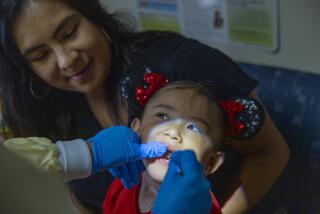Braces no longer just for big kids
- Share via
Thirty years ago, only middle school and high school students wore braces on their teeth; today, it’s not unusual to see kids as young as 7 or 8 with them.
Driving the trend are orthodontists who say that starting treatment earlier can prevent more complicated problems. Others, however, recommend delaying or withholding therapy until most, if not all, of the permanent teeth are in place.
For parents, such conflicting advice can be confusing. Jehan Agrama of Los Angeles can attest to that. When her daughter, Anjoum, then 8, began to complain about a crooked front tooth, Jehan felt compelled to have an orthodontist take a look.
He concluded that her palate was too small and her teeth were overcrowded. He then recommended a complex treatment plan to expand the arch and realign the teeth.
But Agrama had doubts about whether such extensive work was necessary -- and decided to get a second opinion. “If they’d told me the same thing, I would have gone ahead and done it,” she says.
The second orthodontist agreed that Anjoum’s teeth were crowded, but he felt she was too young to start treatment and advised leaving the teeth alone for the time being. “I was so relieved,” Agrama recalls.
Orthodontists on both sides of the issue make compelling arguments for their positions. Those who advocate early intervention believe that treatment can influence development of the dental arch and prevent more serious problems when the permanent teeth erupt. In a child whose teeth are misaligned because they’re too crowded, for example, an “expander” can help enlarge the arch, creating space and preventing more severe crowding. In a child with an overbite, headgear can slow the outward growth of the upper jaw.
Although these types of early interventions can sometimes eliminate the need for later orthodontic treatment, in most cases, a second phase of treatment is required.
Opponents of early intervention argue that it’s being over-utilized -- suggesting that some children are receiving unnecessary treatment. Some problems will correct themselves if left alone. For example, a space between the two front teeth may close after the surrounding teeth fall out and larger permanent ones grow in; crooked teeth might straighten as the arch grows and increases in width.
Most studies, these orthodontists point out, suggest that the long-term outcomes of early treatment are similar to those achieved with the more traditional approach of starting later.
Furthermore, early treatment has clear downsides. Children often wind up spending more time in braces with two-phase treatment, placing them at greater risk of problems such as dental decay. Typically, more time means more money. And young children in particular may not be ready to maintain and care for their braces.
“It’s a responsibility to wear orthodontic appliances -- a responsibility some of these little kids are not ready to undertake,” says orthodontist Harry Aronowitz of Beverly Hills.
For the average child with crooked teeth or a bad bite, the wait-and-watch approach is often the best course.
Some experts suspect the trend of earlier orthodontia is driven, in part, by financial gain. Starting early is a good way to lock patients in (it’s unlikely a patient will switch doctors once therapy has begun), and doctors who elect to postpone treatment may lose patients to more aggressive colleagues.
Sometimes, it’s the parents who push for the braces. Around age 7 or 8, children go through what dentists often refer to as the “ugly-duckling” stage of development. Not all of the permanent teeth have erupted, and those that have come in are often crooked. Driven by the child’s awkward appearance, and fearful of future problems, some parents become impatient.
However, even the most conservative orthodontists generally concede that early intervention is appropriate in select cases. A severe crossbite, for example, may require the expansion of the palate.
Anjoum and her mother have decided to put off treatment for the time being. They visit the orthodontist every six months and hope to know in the next year or so whether braces are necessary.
Anjoum seems perfectly happy to wait. As she put it: “You can’t have candy and gum once you get braces on.”
*
Dr. Valerie Ulene is a board-certified specialist in preventive medicine practicing in Los Angeles. The M.D. appears the first Monday of the month.






